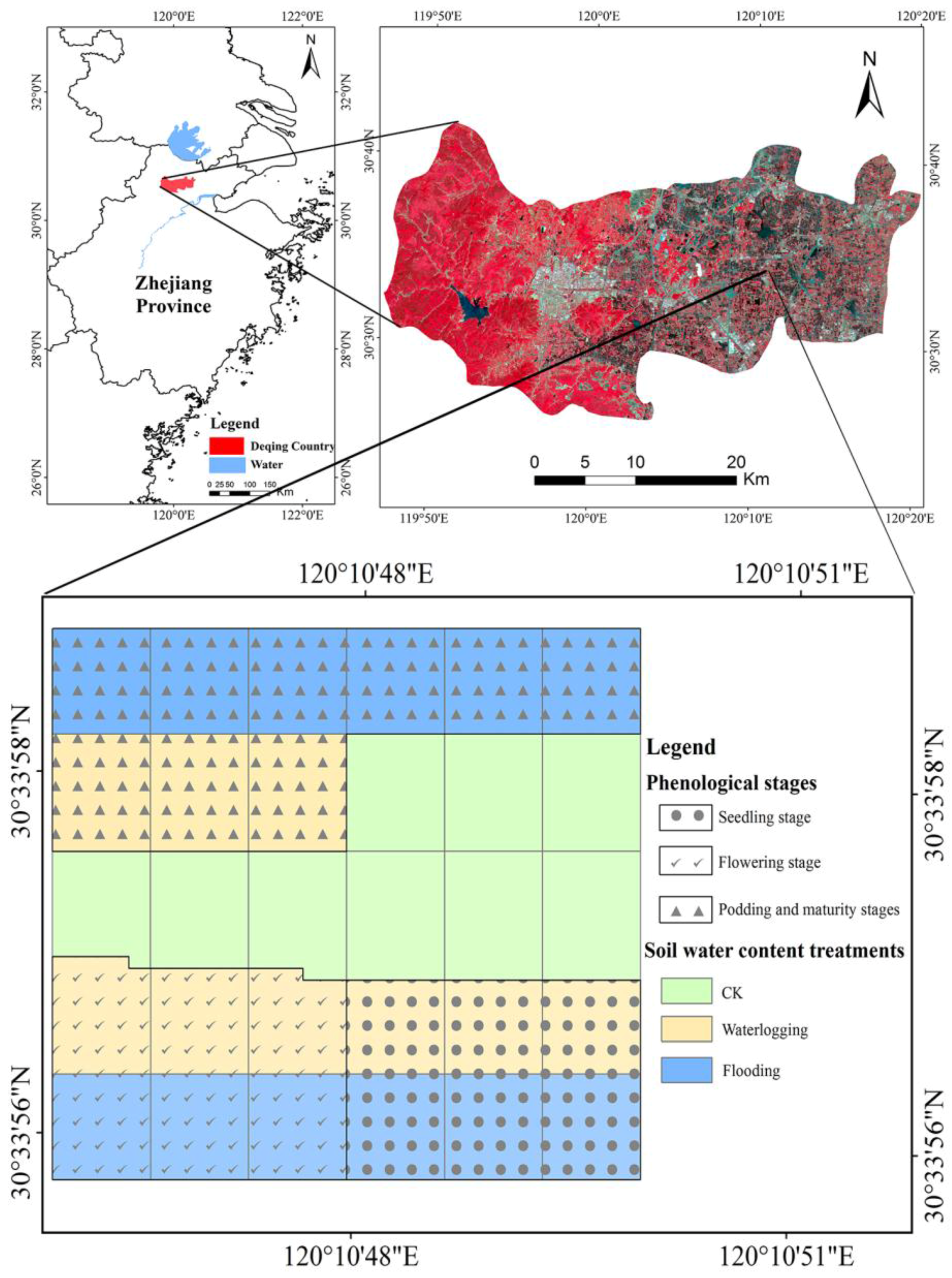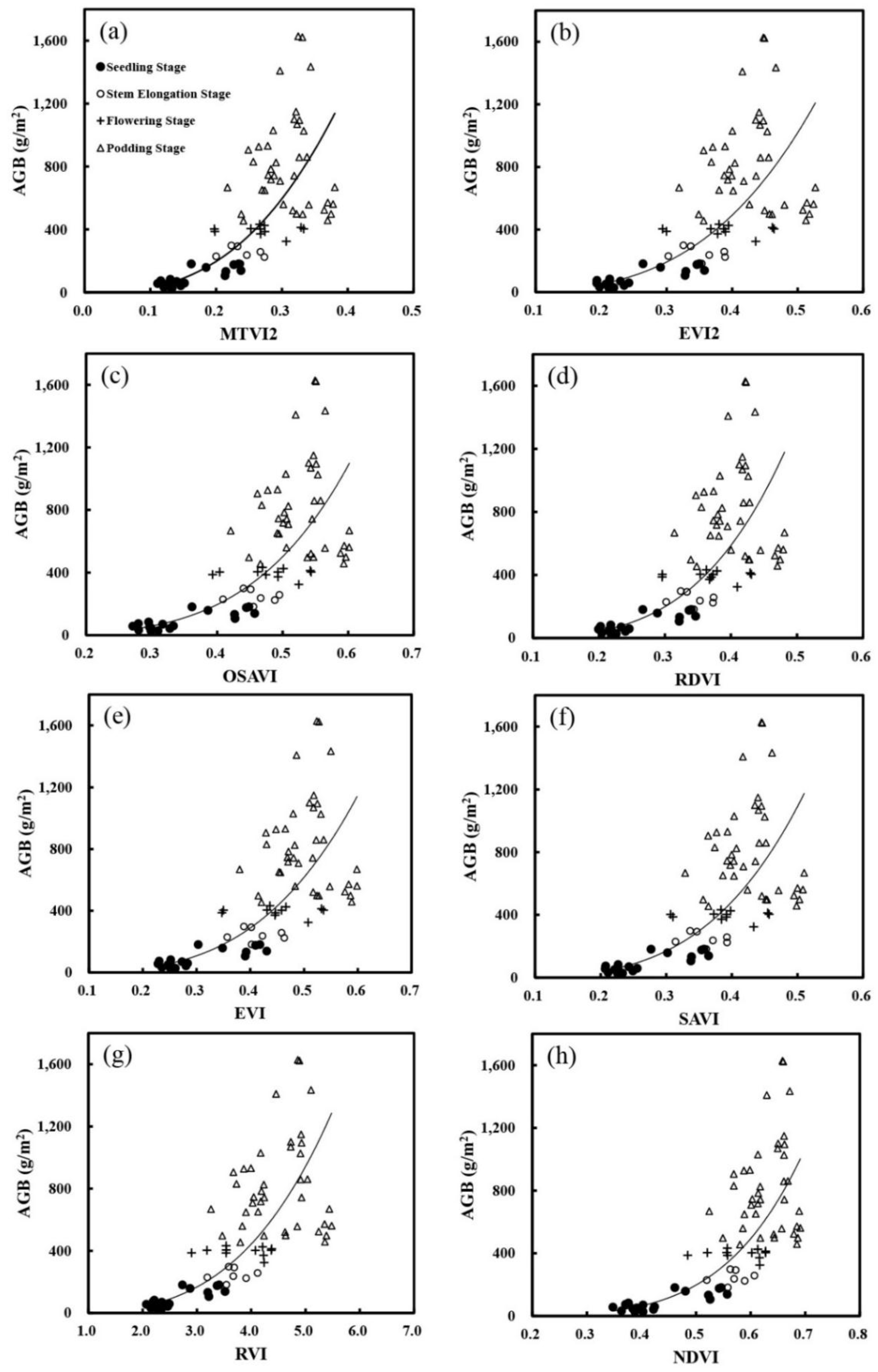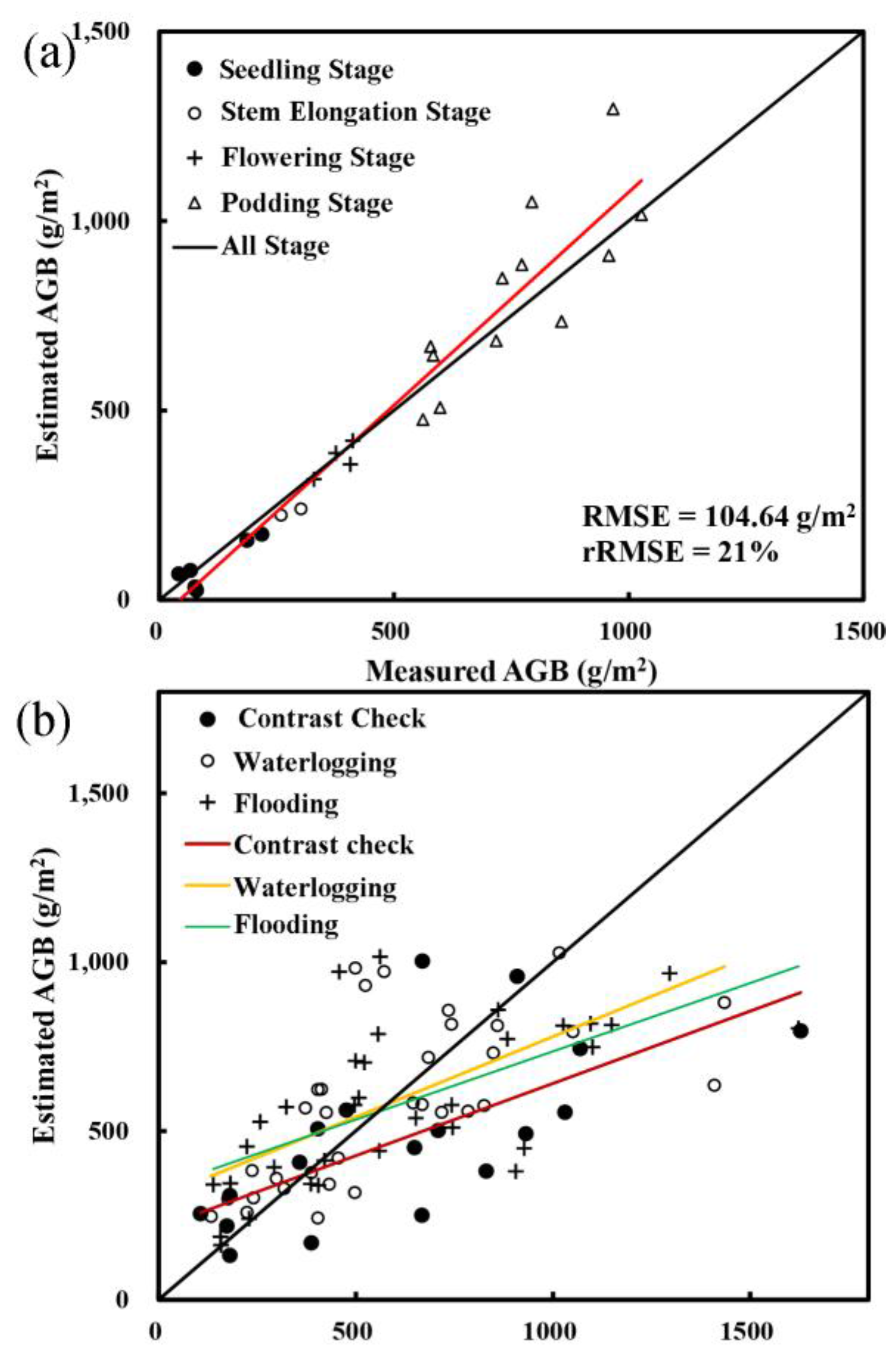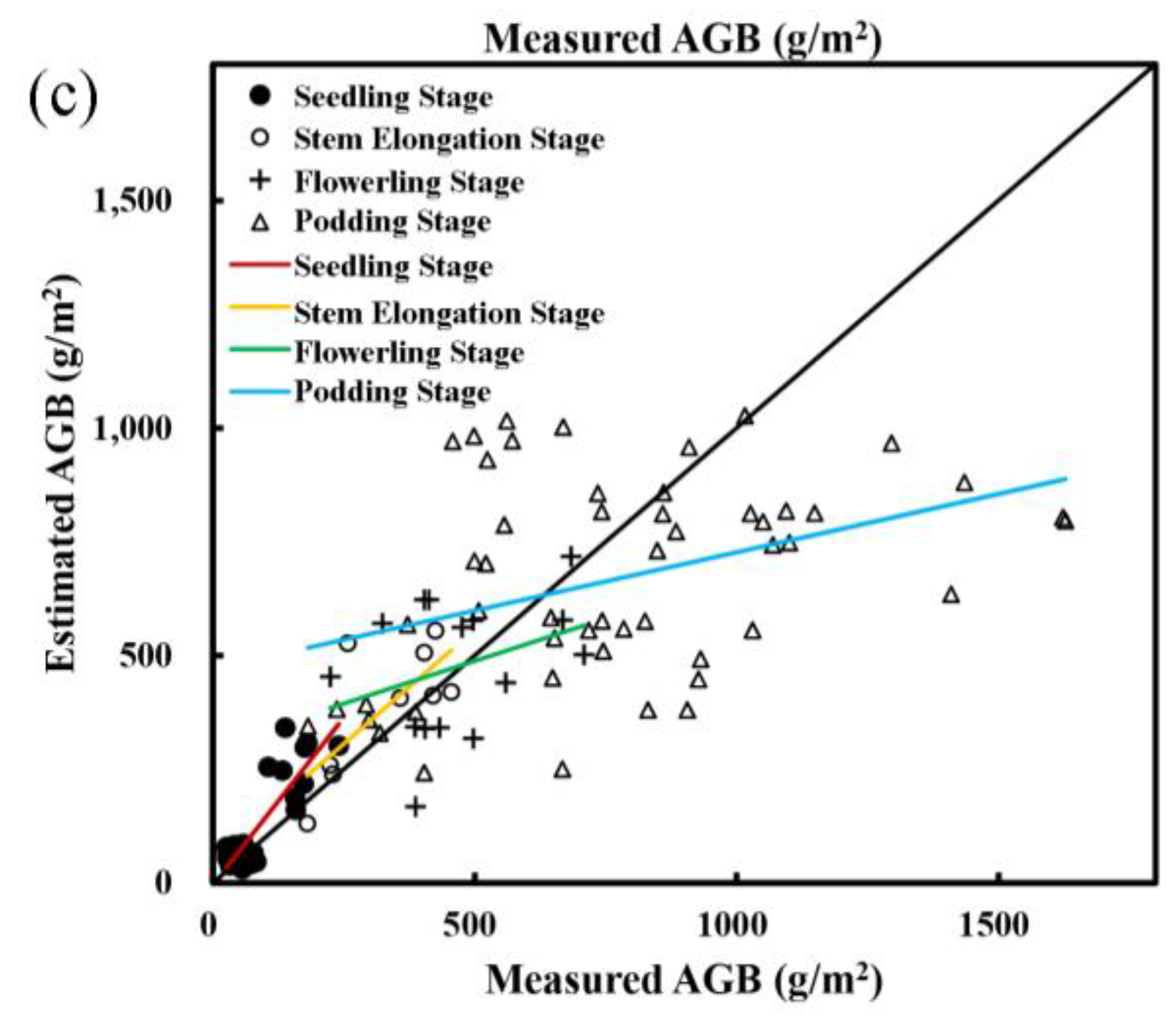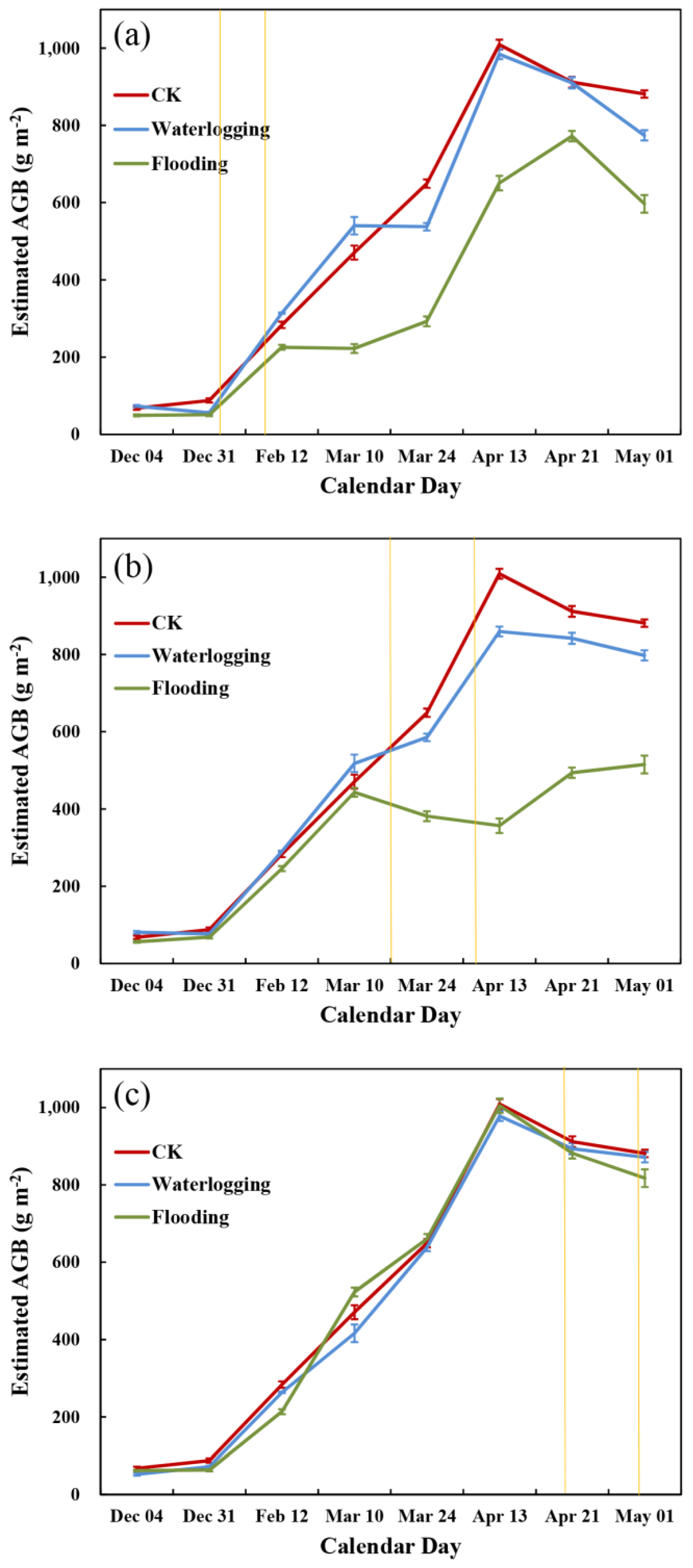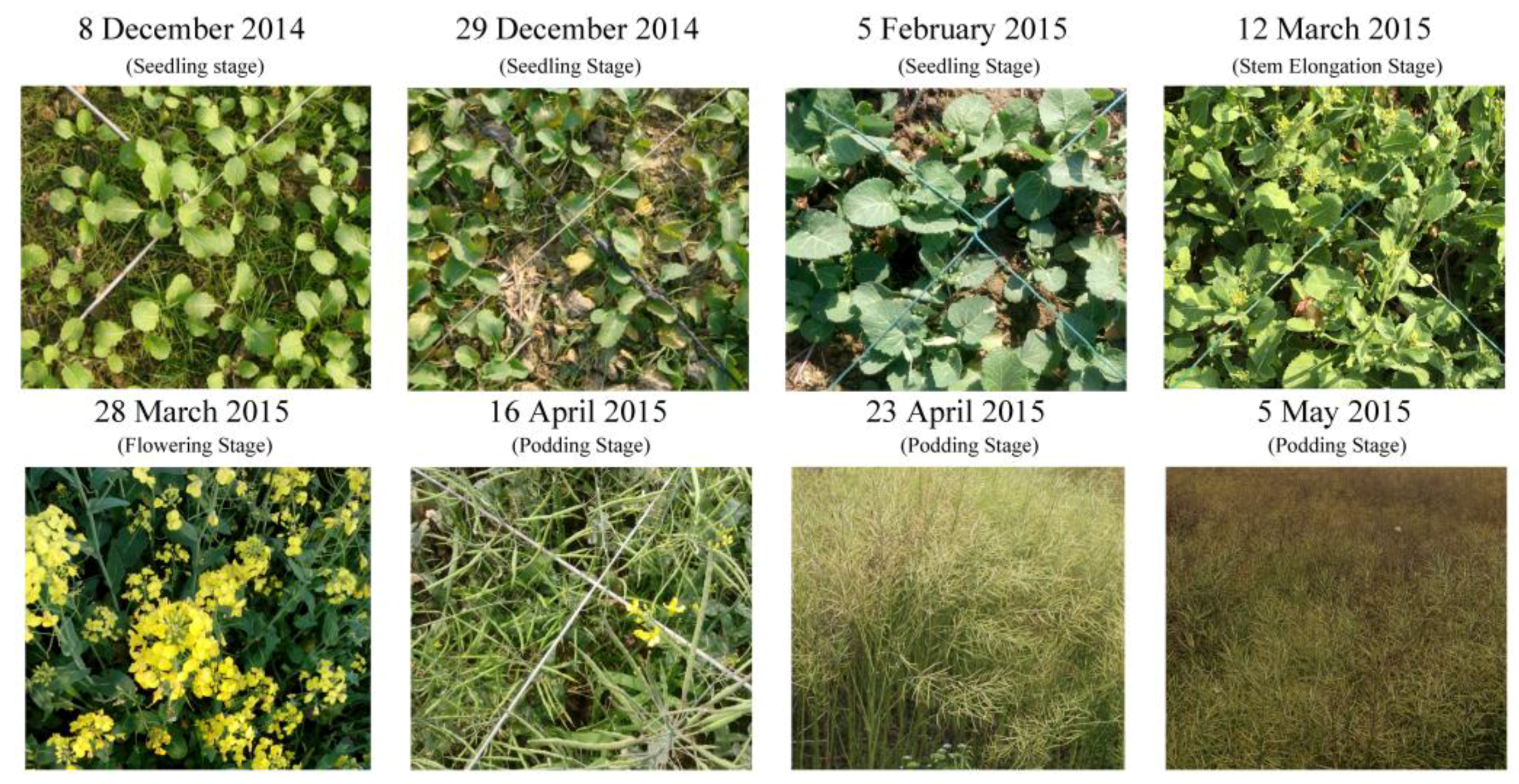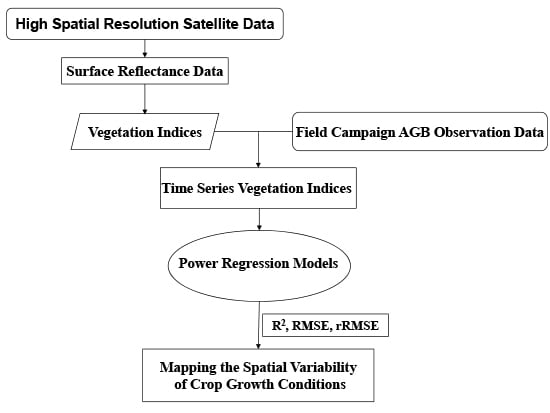1. Introduction
Oilseed rape (
Brassica napus L.) is one of the most important oil crops in China, and mainly grows from autumn to the beginning of the second year summer in the Yangtze River Basin, following by a paddy rice crop [
1]. After the harvest of rice, oilseed rape was sowed in the excessive water stress paddy field, where it often suffers water-flooding in spring and summer and raining in autumns [
2]. Therefore, oilseed rape is susceptible to waterlogging stress during growth stages. Waterlogging stress is a common natural disaster in the Yangtze River Basin, the annual occurrence of the affected area is generally 144.4 million hectares, accounting for more than 20% of the plant area [
3]. The waterlogging stress caused by excessive or saturated soil moisture, can not only change the energy metabolism and physiological processes of the crops, but also impacts the cell structure, morphological features, and yield formation [
4]. Although water is critical for crop growth, excessive water is harmful resulting in lower oxygen levels in the soil and may lead to serious consequences of necrosis, stunting, and defoliation [
5]. Additionally, waterlogging also inhibits plant growth, reduces the accumulated amount of dry matter, and decreases yield drastically [
6]. However, the impacts of waterlogging on different oilseed rape growth stages are different: at the seeding stage, waterlogging stress may lead to soil compaction, which may result in seed suffocation; at the seedling stage, waterlogging causes rape root damage and leaves became red, generally; at the flowering stage and podding stage, the waterlogging not only reduces buds, flowers and pods, decreasing the seed setting rate, but also causes sclerotinia [
7]. Therefore, monitoring crop growth under waterlogging conditions is of great importance at different developmental periods in a target environment [
8].
In recent years, many quantitative procedures have been proposed for water states based on the water budget and plant indicators, mainly based on sensing the plants’ response to water stress rather than directly detecting the soil moisture status [
9]. Few studies have been conducted on different growth stages of field-grown oilseed rape under varying soil moisture [
4,
10,
11]. Detailed field experiments have been predominantly directed toward analyzing the impacts of soil water content variability on physiological parameters and fruit yield [
8,
12,
13]. Indeed, water productivity relates crop production to water use and is a key indicator for evaluating agricultural water management [
9]. Information about vegetation growth and health in the developing season is crucial for optimizing crop production; leaf area index (LAI) and above-ground biomass (AGB) are some very useful indicators for crop growth and health, which can be used to guide the field managements as well as adjustments and requirements [
14]. Traditional field validation of relevant parameters of cover crop growth through destructive sampling are time and cost intensive, which can become particularly cumbersome for regional studies [
15]. Remote sensing offers a rapid and cost-effective way to capture valuable information about agriculture condition over large areas, which can greatly reduce the workload involved in crop investigation or in-field observation and offer the possibility to analyze plant biochemical conditions at a wide range of spatial scales [
16]. Moreover, remote sensing techniques, as well as multispectral reflectance, can provide quantitative information about the water status of many agricultural crops [
17,
18]. Since the first satellite was launched in 1972, a fair amount of available remote sensing datasets and images have become the basic tools for land cover mapping, environmental monitoring, and ecological process scaling from stand to regional and global levels [
19,
20]. Meanwhile, time series observation is particularly important for monitoring seasonal changes in plant growth and development and for studying canopy function [
21].
Most of previous studies adopted coarse- and moderate-resolution remote sensing data. For instance, the Advanced Very High Resolution Radiometer (AVHRR) (1.1 km spatial resolution at nadir), Moderate-resolution Imaging Spectroradiometer (MODIS) (two bands are imaged at a nominal resolution of 250 m at nadir, five bands at 500 m, and the remaining 29 bands at 1 km), and Landsat TM/ETM+ (30 m spatial resolution) have been used to estimate the canopy condition [
22,
23,
24]. However, in many developing countries, smallholder farming is the main livelihood support for the majority of the population. When the field variability can be measured and monitored, site-specific knowledge can assist farmers and stakeholders in better management of their limited resources through new technologies in sustainable agricultural systems [
25]. At the same time, the monitoring of crop growth conditions in smallholder agriculture requires higher spatial resolution satellite data.
Compared with coarse- and moderate-resolution satellite sensors, high spatial resolution optical satellite sensors have a relatively shorter revisiting cycle and are especially useful in capturing finer plant growth information [
26]. In remote sensing, the applications of high spatial resolution optical satellite sensors can be used to obtain images with a spatial resolution of several meters and with a revisit cycle of less than five days, such as Pleiades-1 (0.5 m panchromatic resolution, 2 m multispectral resolution), Worldview-2 (0.46 m panchromatic resolution, 1.85 m multispectral resolution), Worldview-3 (0.31 m panchromatic resolution, 1.24 m multispectral resolution), IKONOS (0.82 m panchromatic resolution, 3.2 m multispectral resolution), and SPOT-6 (1.5 m panchromatic resolution, 6 m multispectral resolution) [
27,
28,
29,
30,
31]. Multiple optical remote sensing sensors are suitable for acquiring time-series data and offer more chances to obtain cloud-free remote sensing images in a very short time, although they cannot escape the impact of constant thick cloud cover [
32]. However, satellite data acquired from different sensors may not be comparable due to its own characteristics, i.e., orbital altitude, spatial and spectral resolutions, wavelength band limits, relative spectral responses of the sensors, etc. [
33]. To model the multi-sensor bands, the spectral response function of each band must be convoluted between different sensors, and the empirical linear method was tested with a satisfactory result to calibrate the multi-sensor images [
32]. Thus, for continuous observing of vegetation seasonal development, it is of great advantage to use accessible data from various high-spatial resolution optical satellite sensors for shortening the revisit frequency and improving the mapping precision to a certain extent [
21].
Moreover, it has been found that the spectral response of vegetation to soil–oxygen deficiency can be detected using hyperspectral remote sensing, regardless of whether the deficiency is the result of waterlogging or oxygen displacement by other gases [
34]. Vegetation indices (VIs) are more sensitive than individual bands to vegetation parameters [
18,
35]. To make better use of spectral data, a large number of spectral VIs have been developed to characterize vegetation canopies, using crop reflectance with different wavelengths. Empirical regression models are often used as a common method for crop biochemical, LAI and AGB estimation by using VIs [
16,
36,
37,
38,
39]. Linear or non-linear relationships have been established between VIs and crop parameters for different vegetation types under varying climatic conditions [
40,
41]. The normalized difference vegetation index (NDVI) is one of the most commonly and widely used indices, which has been interrelated to crop variables, such as LAI, AGB, plant cover, and chlorophyll in cereals [
42]. A number of vegetation indices have shown stronger relationships with biomass, such as optimized soil adjusted vegetation index (OSAVI), ratio vegetation index (RVI), enhanced vegetation index (EVI), green normalized difference vegetation index (GNDVI), the modified triangular vegetation index (MTVI2) and radar polarimetric parameters (RPPs) [
14,
43,
44,
45]. As such, VIs can be used to monitor crop growth, estimate crop physiological conditions, and predict crop yield [
46,
47,
48].
This study investigates the application of four different optical satellite sensors for oilseed rape AGB estimation at the parcel-scale. So far, few studies have been conducted to evaluate the derivative VIs, which can improve the estimation of winter oilseed rape AGB under waterlogging condition. The purpose of this study were (1) to explore the relationships of AGB with several VIs derived from high spatial multiple satellite data; (2) to dynamically monitor the time series crop growth at the parcel-scale; (3) to analyze the impact of different soil water content treatments on the oilseed rape AGB.
4. Discussion
Remote sensing of smallholder agricultural production systems is a great challenge due to the small sizes of cropland, large difference in crop growth cycles, and the mixed cropping and fuzzy field boundaries [
59]. However, over the past few years, with the development of high-resolution remote sensing satellites, it has become easier to obtain remote sensing data with better spatial resolution and temporal frequency at lower cost, which makes the parcel-scale monitoring possible. Numerous studies have revealed that high temporal and spatial remote sensing data can be used to describe the spatiotemporal variability of crop biophysical variables [
14,
21,
30,
40,
60]. It is worth mentioning the more recently Sentinel-2 satellite equipped a multi-spectral instrument (MSI) was launched on 23 June 2015 [
61]. Sentinel-2 data contains 13 spectral bands, 10-meter spatial resolution, and a 10-day retest period. In the optical data, the Sentinel-2A data is the only one with three bands in the red-edge range, which is very effective for monitoring vegetation health information. In addition, The Sentinel-2 data can offer new perspectives for crop biomass monitoring and modeling [
60,
61]. However, little research has been done about the remote sensing of winter oilseed rape AGB using multiple high spatial resolution satellite data [
59]. The current study dynamically mapped the winter oilseed rape growth using time series high spatial resolution satellite data for parcel-scale applications. An overall field campaign was carried out to record the AGB growth of oilseed rape, then an estimation regression model was established and validated. Eight VIs derived from the multiple high spatial resolution satellite images were used to inverse the oilseed rape AGB growth.
VIs combined with different visible and near-infrared reflectance (NIR) are significantly correlated with biomass (
Table 5), and our results are consistent with previous results [
43]. This is mainly due to remote sensing data that have been converted and combined into multiple VIs to minimize the variability of underlying soil, leaf angle distribution and leaf optical properties [
62]. The regression models (linear, exponential, power, logarithm, and quadratic polynomial regression) have been commonly used in crop LAI and dry AGB estimation in previous studies [
21,
44]. A power model was found to be better than the other models in AGB estimation, demonstrating that the near-linear regression models are efficient in establishing relationships between remote sensing data and rape AGB. Estimation of crop biomass using regression models has been well demonstrated by many studies, showing that the power function model has the best accuracy [
63,
64,
65]. A more specific reason may be the growth pattern of rapeseed AGB in this study is more similar to the power model, and that the oilseed rape AGB gradually grew at an extremely low level at the lower VI values, while quickly increasing to a maximum AGB value, at the same time the selected VIs kept increasing with a lower rate. Additionally, the waterlogging and flooding treatments reduced some AGB values, which did not result in an unpredictable sharp increase of AGB.
The best strategy for estimating AGB is using NDVI with a power regression model, but showed a saturation tendency of NDVI at high biomass levels. NDVI calculated from NIR and red reflectance is widely used and correlates well with LAI, fractional vegetation cover, and biomass [
66]. Studies have shown that NDVI does suffer several limitations for robust estimation of biomass and a well-known reason is the saturation effect of NDVI due to the strong absorption of the red reflectance of high AGB [
67]. In this study, the scatterplots in
Figure 2h shows a saturation effect when NDVI is larger than 0.6, AGB becomes saturated with the AGB value, suddenly increasing from 200 g/m
2 to 1800 g/m
2. However, due to the application of waterlogging and flooding treatment, especially the flooding treatment, the treated AGB showed a declining trend compared with the contrast check group, which to a certain extent can reduce the value of the measured AGB and minimize the saturation of NDVI at high AGB. Additionally, the scatterplots also shows that at the podding stage samples were distributed away from the regression curve. In this stage, although the majority of the oilseed rape pods were green, the proportion of oilseed rape pods was high and the canopy became lager at this stage showing relatively large scattering, which may be due to the rapidly growth of the plant canopy biomass or the uncertainty of measured AGB with respect to tiny gap probabilities of the sampling. Moreover, many previous study have used NDVI time series derived from Landsat and MODIS data for forest and grassland AGB estimation [
22,
68].
For the validation based on different soil water content treatments (
Figure 3b), results disclosed that a waterlogging effect can improved the model performance for biomass estimation, mainly due to waterlogging limited crop growth, reduced the AGB value, which improved the estimation accuracy, and this is consistent with Farré‘s study [
69]. Simultaneously, this may be because the NDVI gradually becomes saturated at high AGB, which shows little response to the vegetation AGB and inhibits the treatment variability measured by field campaigns [
70].
For the validation at different oilseed rape growth stages (
Figure 3c), the flowering stage and podding stage apparently have greater impacts on the accuracy verification than that of the seedling stage and stem elongation stage, which may be because crop canopy structural changes and oilseed rape development are significantly correlated, especially during the growth stage from flowering to harvest [
71]. Generally, winter oilseed rape biomass seasonal growth (
Figure 6) developed synchronously with the dynamic maps (
Figure 5) of winter oilseed rape growth. For winter oilseed rape growth, at the early growth stages (seedling stage and stem elongation stage), the soil background could have a strong influence on canopy reflectance. In addition, the rape grows slowly in the seedling stage, which mainly is a period of vegetative organ differentiation and growth. In the stem elongation stage, the main stem elongation increases rapidly, branches of stem appear constantly, and flower-bud differentiation accelerates doubly. However, at the later growth stages (flowering stage and podding stage), the estimates show a slight decrease. The main reason is that, from the beginning of flowering stage, leaf shedding causes leaves reduced drastically, which greatly reduce the photosynthetic area of the leaves, resulting in decreased chlorophyll content. However, the green leaves are still present during this period, and they develop at the lower part of the oilseed rape, under the pod. At the same time, the rapid growth of pods helps increase the assimilation area and photosynthesis. Thus, most of the plant parts that fill the field of view of the sensor are, predominantly, pods. This could be a major reason that the podding stage maps showed a different trend than the crop growth.
As for the response of crops to waterlogging, most of the previous studies put more emphasis on the impacts of waterlogging on photosynthesis and the transpiration rate, plant hormones, antioxidant enzymes, and other physiological and biochemical indices [
11,
13,
47], and the influence of waterlogging stress on plant morphological indices, such as plant height, green leaf number, effective pod number, yield per plant, and 1000-grain weight [
3,
4,
8,
10,
12]; few studies have been done on the vegetation growth and health information, such as LAI and AGB under waterlogging conditions [
69,
72,
73]. In this study, we find that waterlogging stress can reduce the oilseed rape biomass, which has a similar consequence with previous studies [
3,
4,
74]. After the waterlogging treatment is imposed on different oilseed rape growth stages, the response to waterlogging stress of the flowering stage was more sensitive than the seedling stage and podding stage [
4], and for the same rape growth stage, the flooding treatment decreased more than the waterlogging treatment, which is consistent with previous results [
3,
4]. Moreover, at three different growth stages, the estimated AGB of flooding treatment continually reduced, then after a period of time it began to grow slowly, which is the performance of the flooding time-lag. However, the waterlogging treatment at the seedling stage had a better AGB value, mainly because of a severe drought condition in December 2014. These investigations showed that the selected VIs can effectively capture the growth condition under waterlogging treatment at the parcel-scale.
5. Conclusions
In this study, we conducted the winter oilseed rape above-ground biomass (AGB) estimates using vegetation indices (VIs) derived from multiple high spatial resolution remote sensing data. The field experiment was conducted in a consecutive rape growing season spanning from October 2014 to May 2015 by applying three different soil water content treatments (flooding, waterlogging, and contrast check) at three different growing stages (seedling stage, flowering stage, and podding stage) in the Deqing County, Southeast China. The AGB estimating equations were established between the selected VIs and the field measured AGB, and five regression models (linear, logarithmic, quadratic, power, and exponential) were examined to confirm the best empirical regression equations for estimating winter oilseed rape AGB. NDVI based on the power fit function performed better for the AGB estimation. After waterlogging stress, the oilseed rape AGB decreased, flooding treatment performed a more serious impact than waterlogging treatment, and the flowering stage is more sensitive.
This study demonstrated that high spatial resolution satellite data makes parcel-scale monitoring possible, and the multi-source high spatial resolution satellite data can be used to map the time series oilseed rape growth condition. Moreover, the remote sensing technology can capture the variability of crop AGB under waterlogging condition. As more and more high spatial resolution satellites are launched, our study could be a sign of potential application on crop growth, plant area, soil moisture, plant diseases, and insect pests, and serve the purpose of precision agriculture. The estimation of winter oilseed rape after the flowering stage using optical remote sensing data might be a challenge, and more elaborated studies are desired to further assess the property of vegetation indices across different crops, different sites, and different years.
